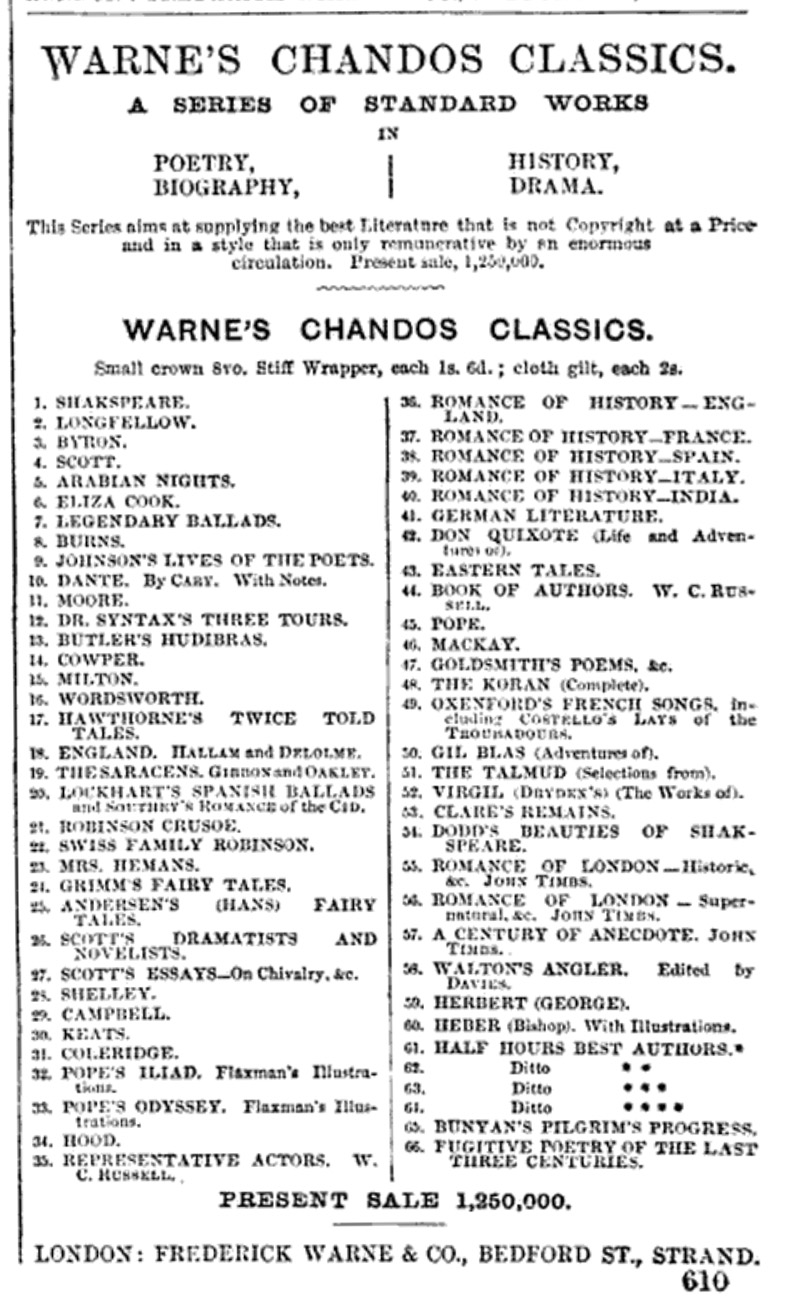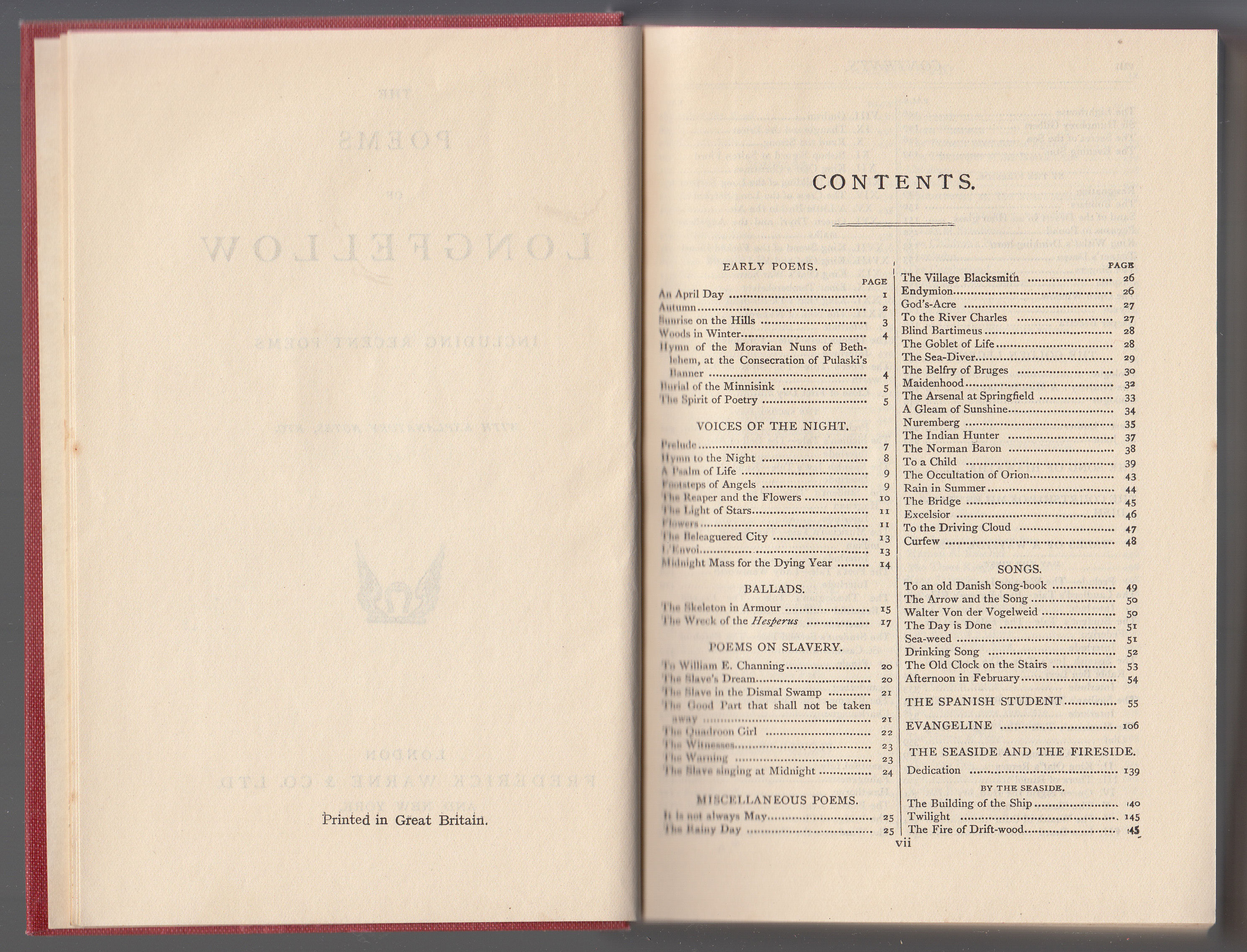Frederick Warne & Co. (London, UK; New York, US)
Series dates: 1868-1926; reissued series 1926-1980
Size: 5.25″ x 7.25″ (1926-1980)
Frederick Warne (b. 1825) was an employee of London bookseller George Routledge from the age of 14. Routledge began publishing books as Routledge & Co. which became Routledge, Warne, and Routledge in 1858. In 1865 the firm was dissolved and two new firms emerged, George Routledge & Sons and Frederick Warne & Co. Several reprint series emerged soon afterword, including the Crown Library (60 titles) and Notable Novels (150 titles). Publisher colophons are shown above. A New York office, focusing especially on children’s books, was opened in 1881. Later, the Star Series and Chandos Classics were issued from the UK office of Warne. The Chandos Classics were also sold out of the New York office of the firm. The Chandos Classics were the only Warne series published extensively in the 20th century. Warne’s UK office was well known for publishing Beatrix Potter and similar juvenile authors.
Mismanagement and economic stresses due to WW1 left the company in trouble by the late teens, and restructuring led to the establishment of Frederick Warne & Co. Ltd. in 1919. The New York branch of the company followed, incorporating in 1920. The firm continues today as an imprint of Penguin Random House. (Much of this quick history taken from “Frederick Warne and Company.” British Literary Publishing Houses, 1820-1880. Ed. Patricia Anderson and Jonathan Rose. Vol. 106. Detroit: Gale, 1991).
The Chandos Classics “sold 3.5 million volumes between 1868 and 1884, and 5 million before Frederick Warne retired in the 1890s.” (Philip Waller, Writers, Readers, and Reputations: Literary Life in Britain 1870-1918, 2008, p. 28).
An advertisement for the new series, and its first title, The Works of William Shakespeare, appears in July of 1868 in the American Literary Gazette. Similar advertisements appear in the UK at the same time.
The Saturday Review listed 66 titles in the series, in an 1878 advertisement:
And 133 titles in 1890, in this advertisement from The Nation (Feb. 20, 1890):
And 150 titles by 1898, in this advertisement in The Athenaeum:
The series seems to have remained in print through the early part of the 20th century, fading somewhat during the WW1 era and the firm’s economic troubles. In 1926 an advertisement (below) in The Bookman (December 1926) promotes the “reissue” of the series in a new format, each title with a “distinctive, ‘duochrome’ jacket.” The initial issue of the new series contains 24 numbered volumes (with a different numbering than the original series).
A listing of titles in the reissued Chandos Classics is included in the back of The Romance of London by John Timbs issued by Warne in 1928. A selection of 152 titles offered in two styles (cloth, library binding) are offered at 5s. and 6s. I think this was near the total number of titles included in the reissued series. Not all titles are listed below (for example, the #1 Shakespeare). This is probably because those titles were out of stock or out of print.
 |
 |
Initial reissues of the Chandos Classics in 1926 included unique, illustrated jackets (as per the advertisement, above). The series name is included on the jacket spine, along with the series number (16 in this case). The front jacket flap describes the series. It mentions the earlier Chandos Classics, issued in the 1870s, as the inspiration for the new series.
The back of the jacket advertises the series and its characteristics. The price is indicated. The rear jacket flap lists the initial 24 titles in the series issued, I believe, in 1926.
Red bindings with debossed design on the front of the book, with the title and author in gold on the book spine.
Endpapers with the series name were printed in green.
The half-title page:
The title page:
The book is undated, the copyright page indicating “Printed in Great Britain.”
Another very similar jacket for The Diary of John Evelyn (undated):
Either at the same time or a bit later a common design jacket appears and seems to be used through the end of the series (a few titles issued as late as 1980). For this common jacket, a modified Oxford cross design is used along with a graphical frame. The color used on all copies of this style of jacket I’ve seen is green, on pale purple paper. Typography is in purple and dark green.
The printed endpapers are replaced by plain paper.
This copy of The Poems of Longfellow is undated, but probably in the 1927-1928 time frame. This title was included as series number 2 in the original series and is the same in the reissued series.
The series name is included on the jacket spine, the front of the jacket, and front jacket flap. The front jacket flap includes a potted history of the series which somewhat misstates (“the early ‘[18]70s) the year the original series was first issued (1868). The great benefits of the series in comparison to other series is also noted.
The rear of the jacket has an elegantly framed encomium devoted to the series, including its laudable characteristics and the price, in this case, 2/6 over-stamped with 3/6 net. The rear jacket flap lists up through series number 61. The series list from the 1928 book (above) lists 152 titles, and a price of 5s., suggesting this book and jacket was issued sometime in 1926 or 1927, before the price increase but with more than the 24 titles listed with the advertisement for the newly reissued series in 1926. This also suggests that the common jacket design was used pretty close to the start of the reissued series in 1926.
Bindings of the reissued series are much plainer than the original series. The title of the book is on the spine, in gold, as well as the publisher. A series colophon and the series name is debossed on the front cover of the book.
A modest half-title page:
The title page:
There is no date anywhere on the book. The copyright page includes “Printed in Great Britain.”
“Printed by the Premier Press, Ltd., London and Bletchley.”





















